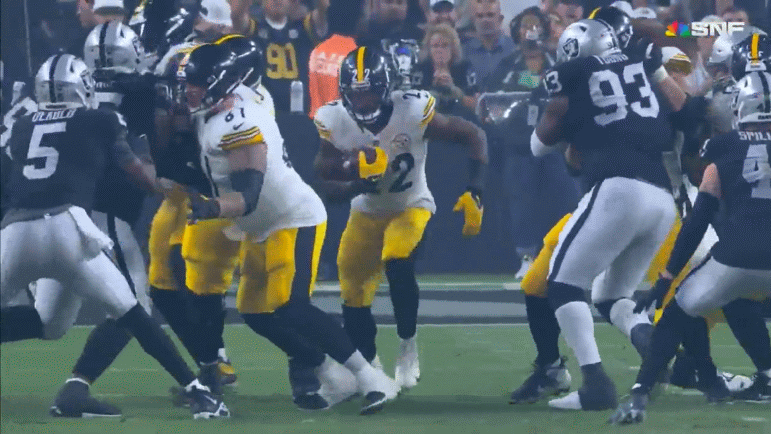Slowly but surely, the Pittsburgh Steelers are working to establish their running game. After struggling to even call running plays in the opener, we have seen flashes the past two weeks, with Sunday’s game being the first time they had more opportunities to commit. While it still lacked efficiency, they topped 100 yards on the ground as a team for the first time in 2023.
The bulk of the work was done by RB Najee Harris, who totaled 19 rushing attempts in the Steelers’ 23-18 win over the Las Vegas Raiders. That only produced 65 yards, a 3.4-yard average, but he generally got better as the game went along until late, when the Raiders committed to stopping the run as Pittsburgh tried to drain the clock. Jaylen Warren also had eight carries for 29 yards (QB Kenny Pickett had 11).
The key to the sustainability of the run game this time around, aside from the fact that they spent a reasonable amount of time playing with a lead, is simple. They got on the same page. Or at least, Harris got on the offensive line’s page.
“Me and the O-line sat down and we talked about what runs we think work best, that they like”, he told reporters after the game, via Mike Prisuta for the team’s website. “And they asked me what I like but I never tell ’em what I like because it doesn’t matter what I like. They like these runs and they executed, so O-line won the game for us”.
Harris’ comment that it doesn’t matter what runs he likes might draw some attention, and not without reason. Intuitively, one might think that it makes a great deal of difference what runs the running back likes, since he’s the one doing the running.
But perhaps Harris sees himself as adaptable to whatever the blocking is. The priority is to get the run blocked up, and wherever that play leads, that’s where the back goes. Harris’ yards before contact are still worse than they were even a year ago (and his yards after is better), but that’s more based on outliers in a relatively small sample size.
There are still the very negative runs that need to be cleaned up, the ones that produce immediate penetration because of poor scheme matching what the defense is showing. The running backs are still getting hit in the backfield too often. That needs to get fixed in a hurry.
But the running backs and the offensive line working to get on the same page, figuring out what they like—at least, what the offensive line likes—is a key step in the right direction. It was only after some frank talks during the bye week last year that things started to change for the better.
Perhaps this leaner run-blocking menu tailored to what the line wants to do is the first step toward getting the ground game to where it needs to be. We did see some successful combination blocking against the Raiders.








